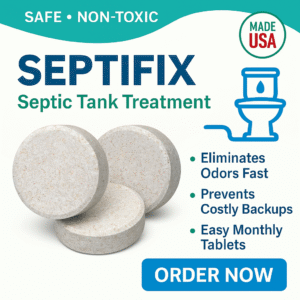Ever think about where your toilet and laundry go after you flush or run them? That water doesn’t vanish—it flows into your septic tank, and then the liquid part (called effluent) moves out into your drain field for final cleanup by soil microbes. When that process gets clogged or bears too much load, your whole system can backfire.
How Septic Tank Effluent Treatment Works
Your septic system does a basic, in-ground wastewater treatment job:
- Primary Treatment: Solids settle in the tank, while oils and lighter matter float.
- Effluent Treatment: This partially clean water moves into the soil, where natural microbes finish the job. ([turn0search2])
But some setups go further to clean water better—with sand filters, aerobic units, vermifilters, or even constructed wetlands. These enhancements improve water quality and protect your leach field and nearby groundwater.
Natural & Engineered Treatment Options
Aerobic Treatment Systems (ATS)
These systems introduce air to fuel aerobic bacteria, which clean effluent much more effectively. Some even disinfect water for lawn irrigation or surface application. ([turn0search19])
Vermifilters
Effluent runs through a bed full of worms that eat solids fast and leave behind much cleaner water than a traditional tank alone. It’s natural, efficient, and low-cost.
Trickling Filters & Biofilters
Wastewater trickles down through a media bed—rocks, gravel, or foam—while oxygen supports a biofilm of helpful microbes that digest contaminants. It’s a tried-and-true method for water polishing.
Constructed Wetlands
These mimic marshes, using plants, soil, and microbes to break down pathogens and remove nutrients like nitrogen and phosphorus—naturally. A green approach to treatment.
Why It Matters
Treating septic tank water properly helps:
- Guard against groundwater contamination
- Extend the life of your drain field and prevent soggy, smelly patches
- Keep regulation-compliant if you discharge above ground
Reminder: 20% of U.S. homes rely on septic systems—so good maintenance isn’t optional; it’s essential.
Maintenance Basics That Help Water Treatment Work
- Pump your tank every 2–5 years, depending on household size.
- Avoid flushing garbage, wipes, grease, or harsh cleaners—stick to toilet paper and waste only.
- Install an effluent filter to prevent solids from clogging your leach lines, which have a finite lifespan (15–25 years).
- Fix water leaks and space out heavy water use to avoid overwhelming your system.
Boosting Your System Naturally
Looking for irritation-free ways to support your tank and treatment? You’re not alone—many folks prefer gentle, eco-safe solutions:
“Antibacterial soaps can kill the beneficial tank bacteria—but normal cleaning use is usually fine.”
Adding beneficial bacteria or enzymes can help steady your system. Products like Rid‑X or Bio‑Active drop-in packets can boost biological activity.
One Tablet That Does It All: SEPTIFIX
Still want maximum effect with minimal effort? That’s where SEPTIFIX comes in. It’s a flushable tablet you drop in the toilet once a month—and it supports septic water treatment by:
- Releasing oxygen to neutralize odors and help clean effluent
- Feeding helpful bacteria for better breakdown of waste
- Supporting overall system balance—helping treatment systems run longer and healthier
In real-world use, homeowners report fewer smells and better system performance when they add SEPTIFIX into their routine.
Real People, Real Advice
“Skip harsh cleaners. Use septic‑safe products, keep up with pumping, and avoid flushing anything but the basics. That’s how systems stay healthy.”
Wrapping Up
Septic tank water treatment spans simple natural solutions to larger mechanical setups like aerobic units or wetlands. Yet regardless of your setup, smart maintenance—pumping, safe habits, and the right monthly treatment—is what keeps things flowing cleanly.
SEPTIFIX makes that easy—just flush one tablet a month and help keep your effluent clean and your system stable. No mess, no guesswork, just smart care.
